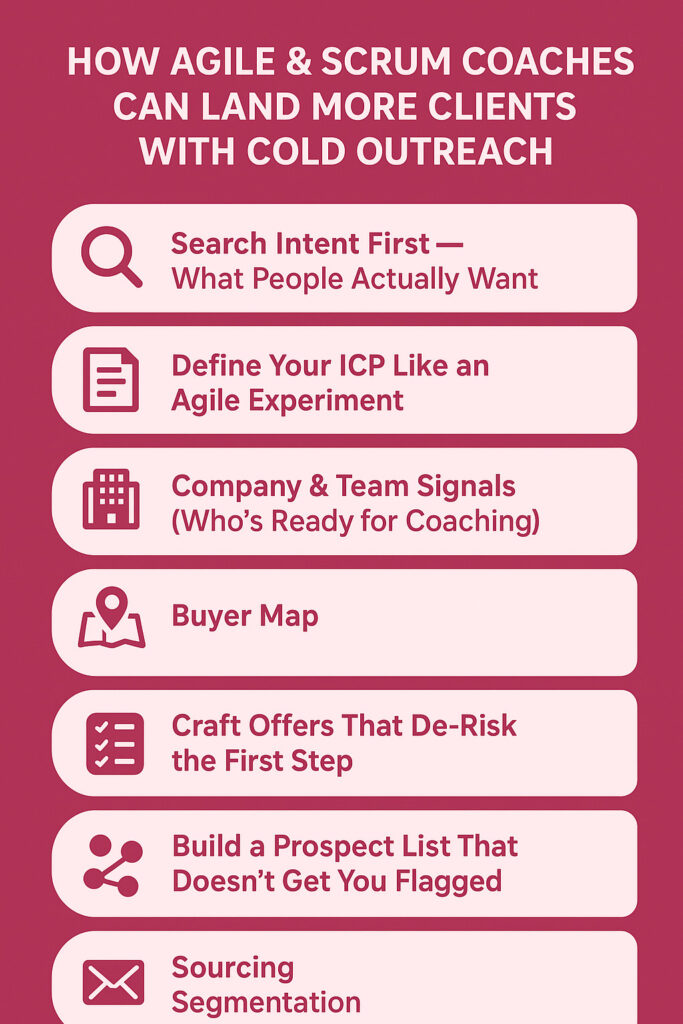
So here’s the deal: most Agile or Scrum coaches I talk to have the same problem. They’re great at what they do, helping teams move faster, kill off “Scrum theater,” and actually deliver.
But when it comes to filling their pipeline? Crickets.
And yeah, you could rely on referrals, but let’s be honest… those come in waves. One month you’re booked, the next you’re wondering if you should update your résumé. That’s where cold outreach comes in.
Done right, it doesn’t have to feel pushy or salesy. It can actually be consultative, helpful, and very “Agile.”
Let’s walk through how you can generate leads as an Agile/Scrum coach using cold outreach step by step, no jargon, no fluff.
How Agile & Scrum Coaches Can Land More Clients with Cold Outreach?
To increase the number of clients for agile & scrum coaches, follow the steps below,,

Search Intent First – What People Actually Want
Here’s the funny thing: when people Google “how to generate leads as a coach with cold outreach,” they’re not looking for theory. They want a playbook. A clear, “do this first, then this, then send this email” kind of guide.
Most of the top articles out there cover:
- Who to target
- How to write short, punchy emails
- Why follow-ups matter
- The boring (but essential) deliverability stuff
All good, but here’s the gap: nobody’s really tailoring this advice for Agile/Scrum coaches.
Define Your ICP Like an Agile Experiment
Okay, step one: know who you’re talking to. You can’t just blast emails into the void and hope someone bites. Let’s narrow this down.
Company & Team Signals (who’s ready for coaching)
The sweet spot? Companies that:
- Have around 80–1,500 employees
- Run multiple Scrum teams (2–15)
- Are either scaling up (Series A–D startups, SaaS, fintech, healthtech) or mid-sized enterprises with digital units
- Show signs of struggling missed releases, lots of hotfixes, carry-over work every sprint
Basically, you’re looking for teams stuck in “Scrum theater” (all the ceremonies, none of the outcomes).
Buyer Map
Who actually signs the check? Usually:
- VP of Engineering, CTO, or Head of Product (for tech orgs)
- CMO or Head of Growth (for marketing orgs going Agile)
- Champions inside: Scrum Masters, Product Directors, Engineering Managers
These folks don’t want more meetings. They want outcomes—faster releases, fewer surprises, and happier stakeholders.
Craft Offers That De-Risk the First Step
Here’s the thing: asking a CTO to invest $ 50,000 in a 6-month engagement based on a cold email? Not happening. You need to take the first step small and low-risk.
Here are a few cold email setup offers that actually get replies:
Sprint Predictability Audit (1-week)
Review the last three sprints, checking commitment versus completion, mapping blockers, and provide them with a 30-day action plan. Outcome? More predictable delivery.
Scrum Anti-Patterns Teardown (2 hours)
This one’s fun. You sit with a team, call out common anti-patterns (“Daily Scrum = status meeting,” anyone?), and give them quick facilitation fixes.
Value Stream Snapshot (10 days)
You map how an idea goes from “sticky note” to “deployed.” Then you highlight bottlenecks and three quick wins. Leaders love this because it connects to ROI.
Agile Marketing Kickstart
For marketing teams: set up a Kanban board, add WIP limits, and build an experiment backlog in two sessions. They’ll feel progress in 30 days, not 6 months.
Build a Prospect List That Doesn’t Get You Flagged
Before you start writing emails, you need names. Good names, aka a good prospect list.

Sourcing
- Use LinkedIn Sales Navigator to filter by role (VP Eng, Head of Product, etc.)
- Look for signals: job postings for Scrum Masters, announcements of “Agile transformation,” or leadership changes
- Enrich with basic info (email, LinkedIn URL, company size)
Segmentation
Don’t lump everyone together. Split by maturity:
- New to Agile: offer a workshop
- Stalled transformation: offer an audit or snapshot
Write Cold Emails That Get Replies
This is where most coaches overthink. Your emails don’t need to be long. They just need to be relevant, short, and clear. Think: 3–4 sentences, tops, to write a good email.
The 3-Sentence Format
- Relevance (show you’ve done your homework)
- Offer (make it small and specific)
- CTA (simple next step 15 min call, quick share, etc.)
Example Templates
Predictability Audit (CTO):
Subject: Quick win for sprint predictability at {Company}?
Hi {First} — noticed {Company} is {Trigger: hiring 3 Scrum Masters / just shipped v3.2}.
We conducted a 1-week Predictability Audit at a similar organization and reduced sprint carry-over by 20%.
Anti-Patterns Teardown (Scrum Master):
Subject: Daily Scrum feels like status?
Hey {First}, quick one: when Daily Scrum = status, focus tanks.
I run a 2-hour teardown that leaves teams with new facilitation scripts for the next sprint.
Want the checklist?
(You get the vibe short, value-first, no hard sell.)
Follow-ups That Aren’t Annoying
- F1 (2–3 days later): “Just wanted to share the 1-pager I mentioned ok to send?”
- F2 (4–5 days later): “We helped a 9-team org cut carry-over 22% want to see how?”
- F3 (1 week later): “Close the loop? Should I circle back in the next sprint?”
Deliverability in 2025 – Non-Negotiables
Here’s the boring-but-crucial part: if you don’t get into inboxes, none of this matters.
Setup Essentials
- SPF, DKIM, DMARC – these tell Gmail/Outlook you’re legit
- Warm up your sending domain (don’t start with 200/day—ramp slowly)
- Keep your list clean (bounce = spam flag)
- Use Google Postmaster Tools to monitor your sender reputation
Trust me, skipping this is like running a sprint without a backlog. You’ll crash.
Run Outreach Like a Sprint (Your Unique Edge)
Here’s where you can lean into your Agile chops. Treat your outreach like an actual sprint.
Backlog
Your “user stories” are hypotheses: {Offer} × {Segment} × {Trigger}. Example: “Predictability Audit for CTOs at Series C SaaS companies.”
WIP Limits
Don’t launch 10 experiments at once. Cap it at 2–3 so you can measure properly.
Daily Stand-ups
Quick check: open rates, replies, positive replies. Adjust copy fast.
Sprint Review & Retro
End of 2 weeks: what worked? What bombed? Double down on winners.
It’s familiar language for you, and it keeps outreach iterative, not overwhelming.
Multichannel Without the Noise
Cold outreach isn’t just email, but don’t overdo it either.
LinkedIn Assist
- View their profile (they’ll notice)
- Like/comment on one relevant post
- Light connection note only after an email touch
When to Add a Call
If they reply with interest, or you get a referral, that’s when you hop on the phone. Don’t start with a cold call. You’ll just get voicemail.
Metrics That Actually Matter
Don’t obsess over vanity metrics. The ones that count:
- Open rate (proxy for deliverability)
- Reply rate
- Positive reply rate (not just “unsubscribe”)
- Booked calls
- Qualified opportunities
Pro tip: 10–20% reply rate is solid. Even 5% positive replies can fill a coach’s calendar if you’re consistent.
Tools & Simple Stack
You don’t need 20 tools. You need right cold email tools for example,
- Prospecting: LinkedIn Sales Navigator + manual research
- Sequencing: QuickMail, Instantly, or another reliable sender
- Deliverability: SPF/DKIM/DMARC setup, warm-up tool, Google Postmaster
That’s it. Don’t get distracted by shiny SaaS toys.
FAQs
Q: What’s a good reply rate for Agile coaching outreach?
A: 10–20% is healthy, with 5% being positive replies.
Q: Should I include pricing in the email?
A: Nope. Just sell the next step. Talk numbers later.
Q: How many follow-ups is too many?
A: Stick to 3–5. After that, you’re noise.
Conclusion Keep It Agile, Keep It Human
Here’s the thing: cold outreach doesn’t have to be awkward. If you treat it like an Agile experiment, small offers, short cycles,and constant iteration. You’ll learn what works way faster than just waiting on referrals.
Start small, keep it personal, and always bring value in every touch. Do that, and you’ll fill your calendar without feeling like a spam bot.


